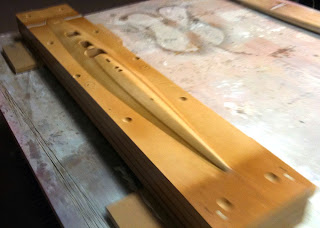A good opportunity to share the thinking that led to the chosen layout.
Initially a dedicated RC tray moulding was designed with the aim of locating the mass of winch, batteries and servo as low in the boat as possible and close to the LCG to minimise pitching.
 |
| Discarded RC tray moulding design |
This solution had drawbacks that seem to be accepted in most existing designs but we thought we could eliminate:
– Dedicated un-reinforced openings in the deck would be required for access, sapping stiffness (or requiring reinforcement in the form of lips or additional laminate that would add weight only to restore the stiffness lost by cutting the openings in the first place).
– The openings would have to be very large if the tray were to be glued into the boat after hull and deck were moulded together.
Even if the size of the openings were minimised by separating them into the three functions (winch, batteries and servo), the tray would not fit through any of the holes.
An option was to create three separate trays. However, because each would have to be larger than the hardware it must accommodate, opening size could not be optimised.
Being unable to drop the tray in through the access openings would have closed the door to one-piece moulding of hull and deck as a unitary laminate.
The lateral solution was to suspend the RC gear in dedicated wells moulded into the deck.
An important design constraint imposed when exploring this solution was to maintain the same low centre of gravity for winch, battery and servo.
The radius into the wells actually adds stiffness to the deck, complementing the inherent rigidity of the chambered shape.
Separate patches over each opening facilitate access and improve watertight integrity.
Another choice that will enhance ease of access is the re positioning of the sheet fairlead to the foredeck.
This solution also simplifies the sheeting run and has secondary advantages such as the elimination of a sheeting post, reduced likelihood of entanglement with other boats, and more direct transmission of sheet forces into forestay tension.











